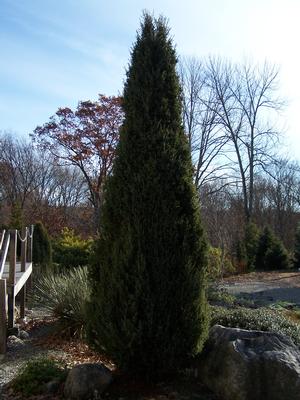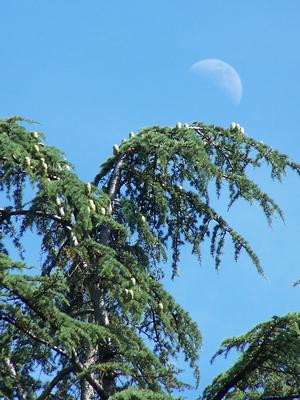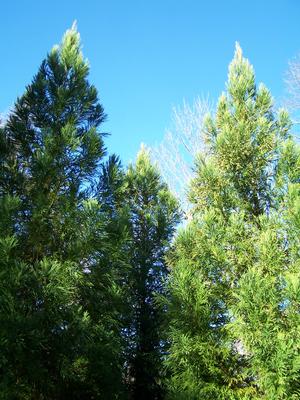
Juniperus communis 'Pencil Point' aka 'Sentinel'

Cedrus libani at Mt. Auburn Cemetery

Cryptomeria japonica 'Yoshino'
Green Conifers and the Pursuit of Happiness
The pursuit of happiness could begin with the greening of your estate. Be it a large property or small implementing green conifers in your landscape will enrich your gardens and everyday lives in all four seasons. Green conifers – it sounds redundant, doesn’t it? But when you consider there are blue, variegated, gold, silver and gray conifers then the coupling makes perfect sense. And there are so many colors of green: dark to black-greens, blue-greens, yellow-greens, sage, pea, celery, spring greens - the list goes on and on. As such a monochrome garden need not be dull; rather, it can be subtle and rich in shades and tints. Green conifers are cooling, salubrious and calming. In that they add a feeling of permanence, age and solidity these qualities alone can bring a modest feeling of quiet peace to our surroundings and a subconscious comfort to our psyches.
Enormous conifers to tiny, most falling somewhere between are available in this golden age of plant introductions. Therefore, a conifer exists for every planting situation. Consider this one practical, utilitarian use: planting a curtain of sheltering green giants on the north and west sides of your home can actually lower your winter heating costs. More money in your wallets should bring you happiness!
Big may not satisfy your fancy. Four season green can be found in the opposite extreme in a collection of dwarf, variously textured conifers placed with a mind towards being able to view them throughout the year. Whether it be near an entrance or visible from a window they will raise and keep your spirits alive and green at all times but especially in the late fall and winter when the days are darkest and the landscape is bleakest.
I hope this list encourages you to consider green conifers in your gardens and your lives.
Cedrus libani var. stenacoma (aka Cedrus libani 'Stenacoma') – Atlas Cedar. ‘Stenacoma’ is a green-foliaged specimen tree chosen for its vibrant hardiness. The short medium green tufts of needles allow for a layered look to the branches that will make for an architecturally interesting and elegant specimen over the decades. It will grow into an upright pyramid. Plant ‘Stenacoma’ in a location sheltered from strong winds. A grove planted on a south-facing slope on a large estate would be breathtaking. A single specimen on an expansive lawn would create a landscape of great character if backed to the left with a cluster of three Acer saccharum (Sugar Maple) and one Gymnocladus dioica (Kentucky Coffee Tree) to the rear right. Add three Aesculus parviflora (Bottlebrush Buckeye) in a group at the front and right as a balancing flounce.
Classification*: Large
Height x Width: 40 to 60 feet high by 30 to 40 feet wide
Light: Full to part sun
Soil: Well-drained loamy soils
Zone: 5 to 9
Chamaecyparis nootkatensis ‘Green Arrow’ and ‘Jubilee’ – Nootka False Cypress, Alaska Cedar or Yellow Cypress. From a perfectly vertical leader side branches slope gradually downward away from the trunk. Dark green pendulous foliage drapes on an artistic, fantastic specimen. ‘Jubilee’ and ‘Green Arrow’ are very similar forms, either lending great character to a landscape. As a vertical accent, ‘Green Arrow’ partnered with Hamamelis x intermedia ‘Arnold Promise’ to the left and Crataegus x ‘Winter King’ (Hawthorn) to the right and rear it would be well-used. Complete this scenario with Cornus sericea ‘Silver ‘n Gold’ (Variegated Yellow Twig Dogwood) to the front and right of ‘Green Arrow’ with Fothergilla ‘Blue Mist’ or Cornus sericea Kelseyi (Dwarf Redosier Dogwood) as a forefront underscore. For something very unusual plant 5 or 7 ‘Jubilee’ in a group: it would be the fantastical and great gathering of the Ents from Lord of the Rings: The Two Towers!
Classification*: Intermediate
Height x Width: 40 feet tall by only 4 to 5+ feet wide at maturity
Light: Full sun to part shade
Soil: moist, rich soils
Zone: 4 to 7(8)
Cryptomeria japonica var. ‘Elegans Nana’ (syn. Elegans Compacta’) – Janpanese Cedar. After six years in my garden the domed spreading outline of this hardier form of Cryptomeria composed of dense, dark green foliage reminds me of a large turtle. t can turn an orange to reddish bronze tone in winter. Protect it from desiccating winter winds. Use it as an anchor in an herbaceous mix with such woodland denizens as Trillium grandiflora, Tricyrtis ‘Lightning Strike’ (Variegated Toad Lily) and Dryopteris erythrosora (Autumn Fern). A combination of C. j. ‘Elegans Nana’, Pieris japonica ‘Little Heath’ and Tiarella cordifolia var. wherryi (Foam Flower) foreplanted with Gaultheria miqueliana, a white-berried species of Wintergreen, would be beautiful.
Classification*: Dwarf
Height x Width: 1 foot tall by 3 feet wide in 15 years
Light: Dappled sun to part shade
Soil: Moist but permeable acid soils
Zone: 5 to 8
Cryptomeria japonica ‘Yoshino’ – This is an exceptionally beautiful, very fast and large growing form of Japanese Cedar. 'Yoshino' is cloaked in rich, dark green foliage all through the year with no winter bronzing. Another fine feature is that 'Yoshino' will form a symmetrical, upright pyramid growing as much as 2 or more feet in a season once its roots settle into the rich, oragnic soil that all Cryptomeria japonica forms prefer. The foliage is especially rich in color and sets even-textured on each stem for a most handsome affect both from afar and upon close inspection. Its bark is medium-light brown and exfoliates finely, vertically. The bark is also very handsome and is an underestimated trait worthy of notice.
Classification*: Large
Height x Width: 30 to 40 feet tall by 20 feet to 30 feet wide in 20 years
Light: Dappled sun to part shade, half shade
Soil: Moist but permeable acid soils
Zone: 5 to 8
Cunninghamia lanceolata – Common Chinafir. Stiff, broad and flattened lanceolate needles emerge from the sides and tops of branches. Bowed like an upside down crescent moon each needle ends in a sharp downward point. Because of the arrangement and shape of the modified needles this amazing tree has loosely the look of the famous Monkey Puzzle Tree (Araucaria). The rich, semi-glossy green of summer may develop into a somewhat bronzed green to a rusty color in late fall. Shelter it from harsh winds. A single lawn specimen will provide endless fascination. But bear in mind: established plants in Zone 5 gardens will likely have some tip die-back in colder winters. In that case use it in a large scheme among other large growing conifers and trees that will help shelter it from north and west exposures. Possible companions might be Aesculus hippocastanum ‘Baumannii’ (Double Horse Chestnut) to the left rear, Cornus mas ‘Golden Glory’ (Cornelian Cherry Dogwood) to the right and Cornus kousa ‘Elizabeth Lustgarten’, a beautiful weeping Chinese Dogwood to the front right.
Classification*: Large
Height x Width: 30 to 60 feet tall by 15 to 30 feet wide at maturity
Light: Full sun
Soil: Moisture retentive acid soils that drain well
Zone: (5)6 to 9
Juniperus communis ‘Pencil Point’ (aka 'Sentinel') – Common Juniper. ‘Pencil Point’ is a handsome, formal and very narrow upright pyramid - almost a column. Another almost indistinguishable twin is 'Arnold'. Though virtually interchangeable they are from different origins hence two different monikers. The branches are erect and thickly cloaked with spiny, awl-shaped foliage. The outline of this plant is that of a narrow flame filled with green foliage touched with some silver and blue. Plant one as a marker at the entrance of a garden path. Place a pair as sentries at a doorway. What about a vertical accent in a conifer planting including graced with Heaths, Heathers and Dwarf Kalmia (Mountain Laurel) as embroidery at their feet?
Classification*: Dwarf to Intermediate in some years, slowing with age
Height x Width: 7 to 9 feet tall by 2 feet wide in 10 to 12 years
Light: Full sun
Soil: Can tolerate quite adverse conditions, acid to calcareous, dry and bony but best in well-drained soils with some organic matter added.
Zone: (2?)3 to 7(8)
Microbiota decussata – Siberian Cypress. In a lightly shaded spot used as a groundcover Siberian Cypress is just beautiful. The slightly arching horizontal sprays of foliage remind one of Arborvitae. The bright green of summer changes to bronze-chocolate in winter. I have a group planted in dappled shade under a Zelkova serrata where they are sprawling happily. One note of caution: Siberian Cypress does not like wet feet. A well-drained situation is crucial for their survival. Certainly more shade is probably reasonably good advice for planting at the warmer end of its range.
Classification*: Dwarf to Intermediate
Height x Width: Up to 1 foot tall by 7(+) feet wide at maturity
Light: Part shade to mostly sun
Soil: Well-drained soils with some organic matter added.
Zone: 2 to 7(8)
Picea abies f. pendula ‘Formanek’ – Norway Spruce. 'Formanek' is one of the most prostrate forms of a conglomerate of pendulous Norway Spruces. One can stake this magnificent shrub for height if that is your bent or simply allow to sprawl and ground cover. Either way it is a particularly handsome plant with an architectural branching pattern that provides a very clean, even appearance. The branches host ¾ to 1 inch needles of a medium to light green. I have heard of it used opulently planted en masse as a ground cover in an open woodland setting. That must be quite a sight! Plant one or more atop a sunny wall so that it will gradually grow down where the handsome branching patterns can be fully appreciated.
Classification*: Uncertain but I will guess Dwarf or a slow Intermediate
Height x Width: depends on if you stake it for height or not. But as a grouncover it will unlikely grow taller than 1 foot.
Light: Full sun is best though it is tolerant of part shade
Soil: Any half decent draining but moisture retentive neutral to acid soil.
Zone: 3b to 7
Pinus banksiana ‘Uncle Fogy’ – Jack Pine. This unusual form sports both contorted and weeping branches all at once. It can be staked for height for a twisting trunk or grafted on a straight standard where it will twist and wend its way toward the ground. Or you could simply allow it to scramble as a groundcover for a wild storm-swept sea at the base of taller neighbors. Either way the stems grow in all directions covered with 2 inch long, dark green needles occurring in pairs. The cones will curiously wrap themselves around and hug the branches. If staked, place ‘Uncle Fogy’, albeit respectfully, as a specimen in front of Miscanthus sinensis ‘Gracillimus’ (Silver Grass) or Miscanthus sinensis ‘Cosmopolitan’ (Variegated Silver Grass) with groundcovering Juniper horizontalis ‘Wiltonii’ (Blue Rug Juniper) or instead, Ajuga ‘Burgundy Glow’ so that dwarf daffodils might come through the mat in the spring. If ‘Uncle Fogy’ sprawls then you might plant it in conjunction with Aronia melanocarpa ‘Viking’ (Black Chokeberry) and Panicum ‘Ruby Ribbons’, a vibrant Switch Grass from the capable hands of Professor Mark Brand from UCONN.
Classification*: Though smaller growing than the species I’m guessing Large. Michael Dirr reports a ground covering specimen that was only 2 feet tall but had spread to 15 feet in the span of 10 years.
Height x Width: Depends upon if it is staked, grafted or left to scramble. As a ground-cover it will may grow to about 2 feet tall.
Light: Full sun
Soil: Light, sandy acid soils with some organic matter in the mix
Zone: 2 to 6(7)
Pinus densiflora ‘Jane Kluis’ – Japanese Red Pine. Though this plant is generally listed as Japanese Red Pine this wonderful shrub is actually a hybrid between Pinus densiflora and P. nigra, the Austrian Pine. The many long straight needles radiate all around the close-set branches forming a low, dense and flat-topped mound. It can be kept smaller by “candling” (removing part or most of the new growth called candles when they emerge and lengthen early in the season). ‘Jane Kluis’ could make a solid anchor in a foundation planting with Acer palmatum ‘Sharp’s Pygmy’ (a marvelous upright dwarf Japanese Maple), Hydrangea quercifolia ‘Little Honey’ (Dwarf Golden Oakleaf Hydrangea) with a foreplanting of Indigofera pseudotinctoria ‘Rose Carpet’ (Rose Carpet Indigo). Throw a Chamaecyparis thyoides ‘Little Jamie’ (Dwarf Atlantic White Cedar) in the mix for evergreen vertical texture.
Classification*: Dwarf
Height x Width: 2 to 2 ½ feet tall by 4 feet wide in 10 to 12 years
Light: Full sun
Soil: Well-draining slightly acid soil with organic matter added
Zone: 3b to 7
Pseudolarix amabilis – Golden Larch. The Golden Larch from China slowly forms an elegant broad pyramid. The lovely needles change from the matte-finished light green of summer to a bright gold to orange-yellow in autumn before the foliage drops. Yes, this is one of several genera of conifers that are deciduous. Male and female parts are found on different branches occurring on the same tree. Beautiful cones form with a glaucous blush over a purplish green. Plant one as a specimen. A row along a length of wall setting a space of at least 25 to 35 feet between each tree would be spectacular. Plant one in a trio with Nyssa sylvatica ‘Autumn Cascade’ (Weeping Black Tupelo) and Picea abies ‘Compressiana’ (a narrow, columnar form of Norway Spruce)... but if you can find it available and if you have the room for goodness sake plant it!
Classification*: Probably straddles the line between Dwarf and Intermediate as it is very slow growing.
Height x Width: 30 to 50 feet tall by 20 to 40 feet wide in a century
Light: Full sun
Soil: Permeable moist acid soils
Zone: (4)5 to 7
Pseudotsuga menziesii ‘Graceful Grace’ – Douglas Fir. ‘Graceful Grace’, the best of the weeping forms of Douglas Fir grows into an elegant specimen. Each plant can develop unique character but all are fantastic. Contorted needles up to one and one half inches long flash a contrasting silvery underside to the matte green finish of the upper. Place her front and center with Quercus robur ‘Fastigiata’ (a columnar form of English Oak) to the rear right and Cornus stolonifera ‘Cardinal’ (Red Twig Dogwood) to the rear left. But don’t crowd ‘Graceful Grace’ as she likes open situations where can dance and entrance!
Classification*: It grows about 12 inches each year placing it between Intermediate and Large.
Height x Width: Dependent on training
Light: Full sun
Soil: Neutral to somewhat acid soils that drain well.
Zone: 3b to 6, possibly into cooler sections of USDA zone 7
Sciadopitys verticillata ‘Cynthia Waxman’ – Japanese Umbrella Pine. The daughter-in-law of the late Sid Waxman from the University of Connecticut is the moniker attached to this remarkable cultivar. ‘Cynthia Waxman’ forms a perfect, gorgeous and dense upright cone. True of all the Japanese Umbrella Pines, the whorls of long and thick dark green needles afford this tree a very unique texture unlike any other conifer. This selection from the able hands of Mr. Waxman grows slower and much tighter than the species. It almost looks as though it had been shaved like a Christmas tree to form a denser plant but this is not the case; the genetic programming of this cultivar does it all. If I was cornered into choosing a favorite Sciadopitys it would be ‘Cynthia Waxman’. This most handsome form of Japanese Umbrella Pine would be beautiful in a mixed collection of Dwarf Arctic Willows backed to one side with Salix x ‘Scarlet Curls’, a fascinating contorted large growing upright willow. Or use as many as required as taller accents at the ends and junctures in a grand, strictly formal garden room. Grow one in your front yard for the perfect living Christmas tree – but please go easy on the Christmas lights!
Classification*: Dwarf as a young plant. We're guessing that 'Cynthia Waxman' will eventually straddle the Dwarf / Intermediate line as a middle-aged tree in some years.
Height x Width: Smaller growing than the speices, probably near 16 feet at maturity but may grow larger eventually. We simply do not know. But know this - it will take a long time for it to achieve largesse.
Light: Full to part sun
Soil: Rich moisture retentive soils
Zone: (4)5 to 7
Happiness is a state of mind. Including conifers in your planting schemes can cheer your heart, spruce-up your gardens and properties, and even save you money in winter heating costs. Finding the spaces in which they will fit is fun and adventurous – that alone will bolster your level of joy. Planting a collection of rare cultivars with unusual textures and outlines will enrich not only your property but your "inner garden", too. Break out those shovels! Approach your project with gusto! The greening of your lives begins today. Happiness is but a green conifer away. Peace.
*The American Conifer Society’s growth rate categories are as follows:
- Miniature: up to 1 inch per year. Estimated size in 10 to 12 years is up to 1 foot.
-
Dwarf: average rate of 1+ to 6 inches per year. Estimated size in 10 to 12 years is 1+ to 6 feet.
-
Intermediate: average rate of 6 to 12 inches per year. Estimated size in 10 to 12 years is 6 to 12 feet.
-
Large: average rate of 12 or more inches per year. Estimated size in 10 to 12 years is 12 feet or more.
Penned by Wayne Paquette, December 2005